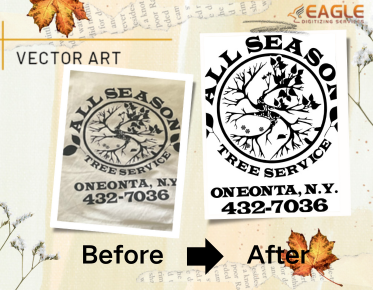Unlock Your Creativity: Customization Ideas for Vector Art and Stickers!
The World of Customization
Welcome to the vibrant world of customization, where creativity knows no bounds and personal expression reigns supreme. In recent years, the demand for personalized products has skyrocketed, allowing individuals to make their mark on everything from apparel to home decor. Among the most popular personalized items are custom stickers, which offer a fun, versatile, and affordable way to showcase one's unique style and ideas. For the best vector art conversion services, please feel free to contact us.
The Rise of Personalized Products
The surge in personalized products can be attributed to several factors. Consumers crave uniqueness and individuality, wanting products that reflect their personal tastes and interests. Advances in technology have made it easier than ever to create custom items, with online platforms and digital tools simplifying the design and production processes. Additionally, social media has amplified the trend, as people love to share and show off their bespoke creations.
Vector Art: The Heart of Customization
At the core of many customized products lies vector art. Vector graphics, made up of paths defined by mathematical equations, provide the precision and scalability necessary for high-quality designs. Unlike raster images, which are pixel-based and can become blurry when resized, vector art maintains its sharpness and clarity at any size, making it ideal for a wide range of applications.
Understanding Vector Art: Basics and Benefits
Vector art is created using points, lines, and curves, which are connected to form shapes and designs. The main benefits of vector art include scalability, flexibility, and small file sizes. These attributes make vector graphics perfect for logos, illustrations, and, of course, custom stickers. With vector art, you can resize your design to fit a tiny sticker or a large poster without any loss of quality.
Why Vector Art is Perfect for Stickers
Stickers need to look great in various sizes and on different surfaces. Vector art's scalability ensures that your sticker design will be crisp and clear whether it's small enough to fit on a laptop or large enough to adorn a car bumper. Additionally, vector graphics are easy to edit, allowing you to make quick adjustments and variations to your designs.
Popular Software for Creating Vector Art
Several software options are available for creating vector art, each with its own set of features and advantages:
● Adobe Illustrator: The industry standard, known for its comprehensive toolset and professional-grade capabilities.
● CorelDRAW: A powerful alternative to Illustrator, favored for its user-friendly interface and robust features.
● Inkscape: A free and open-source option that's perfect for beginners and advanced users alike.
● Affinity Designer: An affordable yet feature-rich program that's gaining popularity among designers.
Designing Your First Vector Art: Tips and Tricks
Starting with vector art might seem daunting, but with a few tips and tricks, you'll be creating stunning designs in no time. Begin by sketching your ideas on paper to establish a clear concept. Use basic shapes to construct your design, and don't be afraid to experiment with different layouts and color schemes. Remember, simplicity often leads to the most striking results.
From Concept to Creation: Planning Your Vector Design
Planning is crucial to successful vector design. Define the purpose of your sticker and your target audience. Create a mood board to gather inspiration and refine your ideas. Break down your design into manageable components, and decide on the elements you want to include. This planning phase will make the actual design process smoother and more efficient.
Mastering the Pen Tool: Your Best Friend in Vector Art
The Pen Tool is a fundamental tool in vector art creation. It allows you to draw precise paths by placing anchor points and adjusting their handles. Mastering the Pen Tool requires a long time of practice, but it is well worth the effort. Start by tracing simple shapes and gradually move on to more complex designs. This skill will give you greater control and flexibility in your artwork.
Coloring Your Vector Design: Techniques and Tools
Color brings your vector design to life. Use the Fill and Stroke settings to add color to your shapes. Experiment with gradients to create depth and dimension. Play with color palettes to find the perfect combination for your design. Tools like the Color Guide in Illustrator can help you choose harmonious color schemes that enhance your artwork.
Adding Textures and Effects to Your Vector Art
Textures and effects can add a unique touch to your vector art. Use texture fills to give your design a tactile feel. Apply effects like shadows and glow to create a sense of depth and realism. Be mindful of not overloading your design with too many effects; subtlety often works best.
Creating Custom Stickers: A Step-by-Step Guide
Creating custom stickers involves several steps. Start by finalizing your vector design. Next, choose your sticker size and shape. Use design software to place your design on a sticker template. Add any necessary bleed areas to ensure your design extends to the edge of the sticker. Finally, export your design in the appropriate format for printing.
Choosing the Right Materials for Your Stickers
The material you choose for your stickers affects their durability and appearance. Vinyl is a popular choice for its water resistance and longevity. Paper stickers are more eco-friendly but less durable. Consider the intended use of your stickers when selecting the material – for example, vinyl is better for outdoor use, while paper is suitable for indoor applications.
Printing Options for Custom Stickers: DIY vs. Professional
You can print custom stickers yourself or opt for professional printing. DIY printing allows for more control and immediate results, but it requires a high-quality printer and materials. Professional printing services offer higher quality and a range of finishing options, such as matte or glossy coatings. Weigh the pros and cons of each method based on your needs and budget.
Best Practices for Exporting Your Vector Art for Printing
When exporting your vector art for printing, ensure you use the correct file format, such as PDF, AI, or EPS. Set the resolution to at least 300 dpi for optimal print quality. Include bleed areas to account for any trimming errors. Check the color mode – CMYK is preferred for print, while RGB is used for digital displays.
Ensuring Color Accuracy in Your Printed Stickers
Color accuracy is vital in printed stickers. Calibrate your monitor to ensure the colors you see on the screen match the printed output. Use color profiles to manage color consistency across different devices and printers. Request proof from your printer to check colors before committing to a full print run.
Cutting Techniques: Die-Cut, Kiss-Cut, and More
Different cutting techniques can give your stickers unique shapes and finishes:
● Die-Cut: Cuts through both the sticker and backing, creating a custom shape.
● Kiss-Cut: Cuts through the sticker without cutting the backing, making it easier to peel off.
● Laser Cutting: Offers precise cuts for intricate designs.
Choose the technique that best suits your design and application.
Applying Your Stickers: Tips for a Smooth Finish
Applying stickers smoothly can be tricky. Clean the surface thoroughly to remove any dust or oils. Peel the backing slowly to avoid touching the adhesive. Smooth down any air bubbles with a squeegee or a credit card when applying the sticker. For larger stickers, consider the wet application method using soapy water to help position the sticker correctly.
Marketing Your Custom Stickers: Strategies and Tips
Marketing your custom stickers involves several strategies. Use social media platforms to showcase your designs and engage with your audience. Offer promotions or limited-time discounts to attract customers. Collaborate with influencers or other brands to grow your audience. Attend local markets and events to sell your stickers in person and connect with potential customers.
Setting Up an Online Store for Your Custom Stickers
Opening an online store is vital for reaching a larger audience. Platforms like Etsy, Shopify, and BigCartel make it easy to create a professional-looking store. Ensure your product listings are detailed and include high-quality photos. Offer multiple payment and shipping options to cater to different customer preferences.
Social Media Promotion: Showcasing Your Sticker Designs
Social media is a powerful tool for promoting your custom stickers. Share behind-the-scenes content of your design process to engage your audience. Use hashtags to reach a broader audience and join relevant communities. Host giveaways and contests to generate excitement and encourage sharing. Collaborate with other artists and influencers to increase your visibility.
Collaborating with Other Artists: Expanding Your Reach
Collaborating with other artists can help you reach new audiences and gain fresh perspectives. Partner on joint projects or create limited edition sticker packs together. Share each other's work on social media and tag one another in posts. Collaborations can also lead to exciting new ideas and creative growth.
Trends in Custom Sticker Design
Stay ahead of the curve by keeping an eye on trends in custom sticker design. Popular trends include holographic stickers, hand-drawn illustrations, and eco-friendly materials. Pay attention to what's gaining traction in the market and incorporate these trends into your own designs to stay relevant and appealing.
Challenges and Solutions in Sticker Customization
Sticker customization can come with challenges, such as maintaining quality across different print runs or dealing with complex designs. To overcome these, work closely with your printer to ensure consistent results. Simplify intricate designs where necessary and always test print before mass production to catch any issues early.
Inspiration: Creative Sticker Ideas to Get You Started
Need some inspiration? Consider creating stickers that reflect popular culture, such as quotes from TV shows or movies. Nature-themed designs, like flowers and animals, are always popular. Customizable stickers, where customers can add their own text or elements, offer a personal touch. Don't be scared to experiment and discover your own distinctive style.
Sustainability in Custom Stickers: Eco-Friendly Options
Sustainability is becoming increasingly important in product customization. Opt for eco-friendly materials like recycled paper or biodegradable vinyl for your stickers. Use soy-based or water-based inks to reduce environmental impact. Promote your commitment to sustainability as a selling point to attract eco-conscious customers.
Vector art and custom stickers offer endless possibilities for creativity and personal expression. By understanding the basics of vector design and the intricacies of sticker production, you can create unique and high-quality products that stand out. Embrace the realm of personalization, try new ways, and let your originality show. Whether you're designing for fun or starting a business, the combination of vector art and stickers is a powerful tool for bringing your ideas to life.



